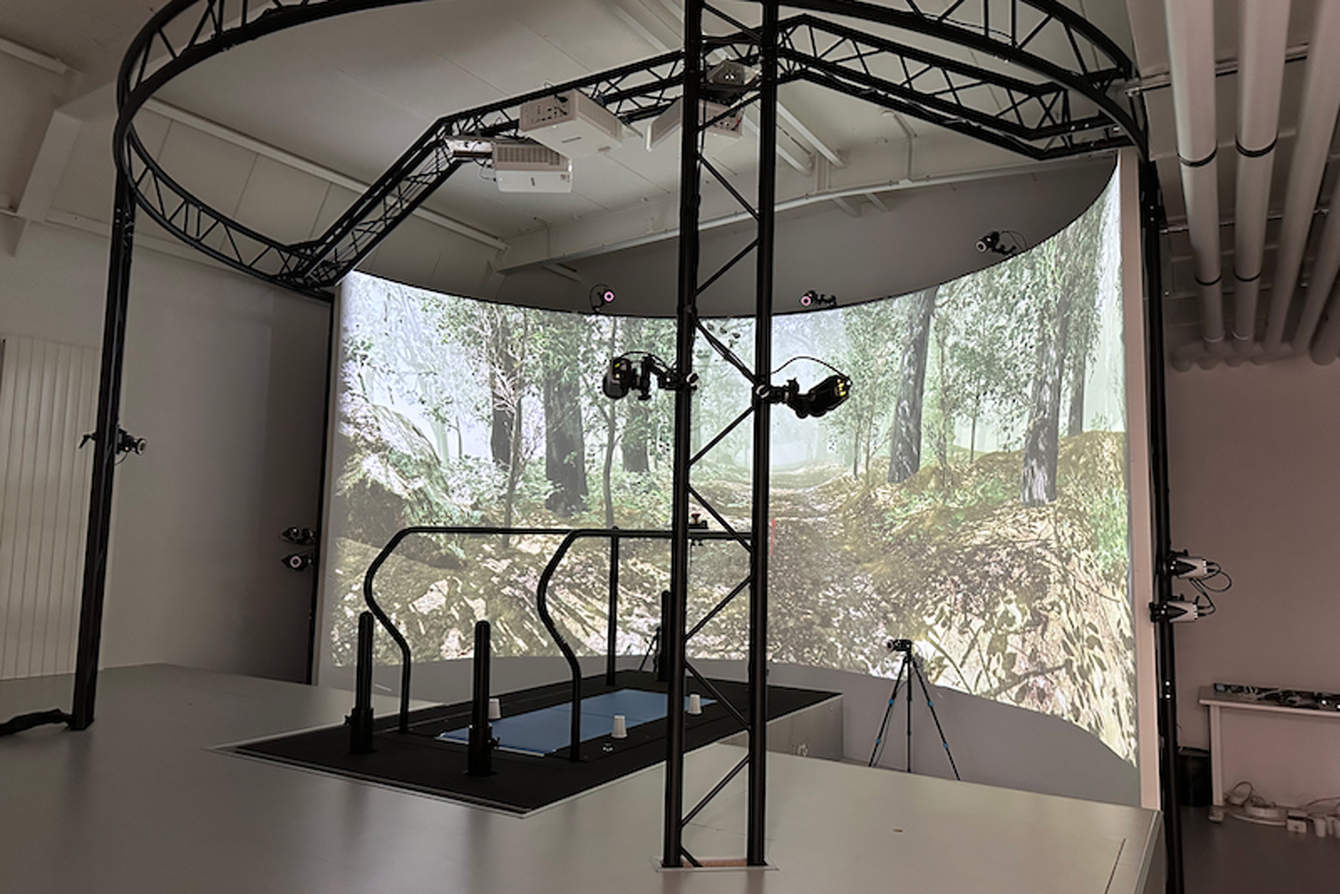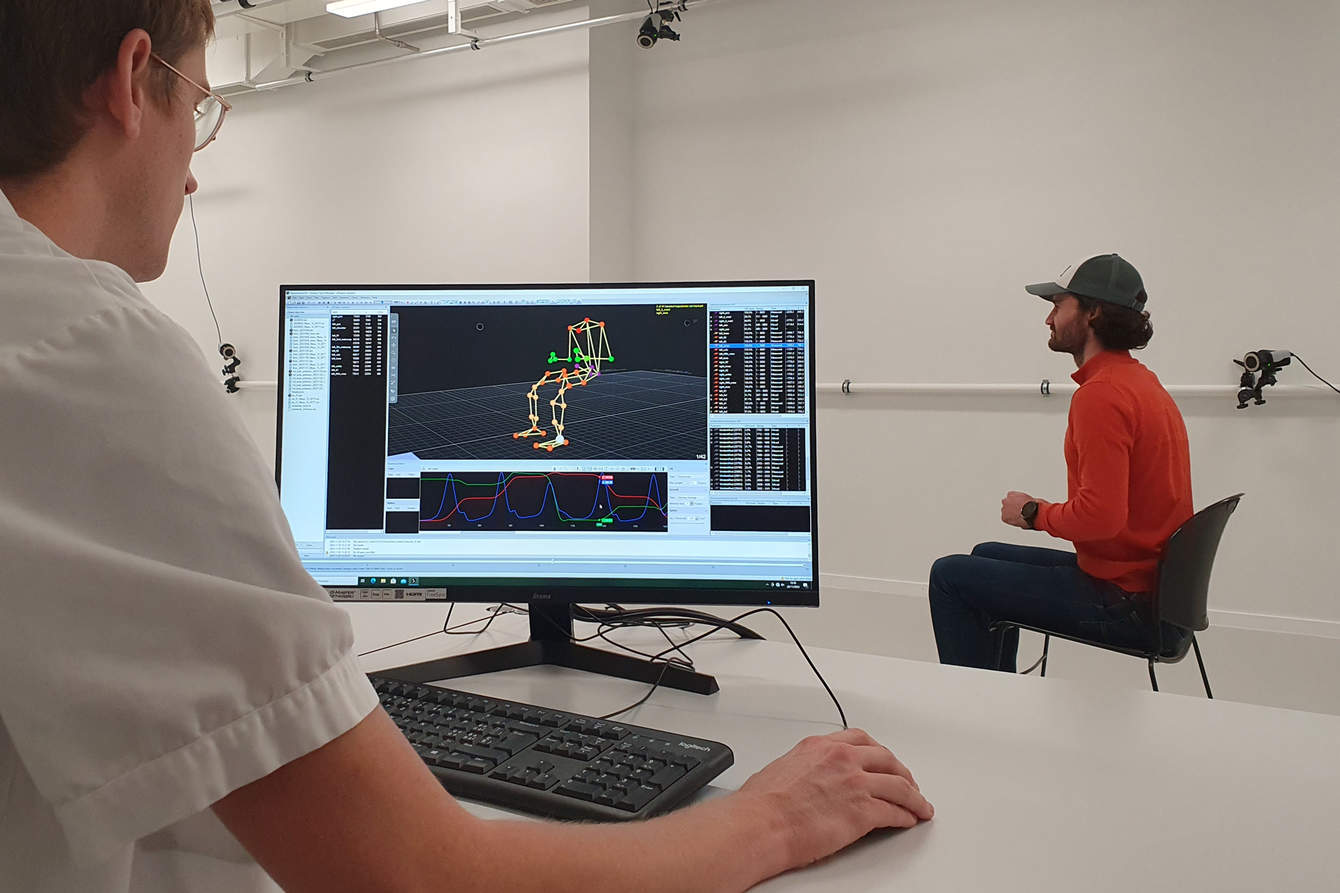
A new way to walk the walk
Publié il y a 9 mois
18.08.2024
Partager

Leaves are falling; the sun starts shining through the trees. The walk seems bucolic, but it takes place in a room on the fourth floor of the CHUV Orthopedic Hospital. The Swiss BioMotion Lab studies walking, in particular its impact on diseases such as knee osteoarthritis. In a room full of cameras with a smart floor, the patient equipped with small sensors walks at their own pace. Their movements, the strength in their joints, and the activity of their muscles are then observed and measured.
Created in 2014, the Swiss BioMotion Lab will open its new space in September 2024. It has the only equipment of its kind in the world, consisting of a huge curved screen facing a medical treadmill. “This innovation opens up many new perspectives, says Julien Favre, a PhD in biomechanics and co-director of the laboratory. Until now, we could only record a few steps in a corridor. This new method allows us to make the patient walk in an immersive context – with walks in the forest or in the city of Lausanne – where he can perform actions while strolling.”
The cutting-edge device can create a digital twin. “The walking signature of a person is reproduced on the screen with a 3D avatar, explains Julien Favre. Depending on the malfunctions observed, we can correct the movement by incorporating a custom animation of the desired actions into the video. The patient then moves into their avatar to reproduce the correct movement.” This method also allows us to study how to reduce pain and slow the progression of osteoarthritis in the knee, explains Professor Brigitte Jolles-Haeberli, orthopedic surgeon and co-director of the laboratory. “At a more advanced stage of the disease, these walking data should also help to determine which type of surgery is most appropriate, design custom prostheses, and come up with user-customized rehabilitation training.”
The challenge of arthritis
Arthritis is a chronic disease that affects the functioning and tissues of a joint, such as the knee, hip, elbow, etc. The disease is characterized by pain and severe stiffness. It is a real public health problem, affecting 60% of people over 60 and costing more than 1.5 billion francs per year in Switzerland. And the trend is on the rise, especially when it comes to knees. “A couple of years ago, I operated as many hips as knees, notes Brigitte Jolles-Haeberli, recently elected to the French Academy of Surgery. Today, knee operations are much more frequent.” The reasons: “An increase in the practice of sports that induce repeated shocks, such as football, skiing or running, sometimes causing ligament or meniscus damage in the knee, but also excess weight and increasing obesity, which increase stress on the joints.”
The new facilities at the Swiss BioMotion Lab will also increase the number of patients received daily and bring clinical practice and research closer together. “This change of scale – combined with the artificial intelligence tools that will allow us to process more data – will make it possible to achieve more comprehensive and integrated models for patient management, adds Jolles-Haeberli. Clinical partnerships for other pathologies involving movement impairment are also being developed.”
The risks of a sedentary lifestyle
“Walking is a complete physical activity, explains Mathieu Saubade, Sports Medicine doctor at CHUV and Unisanté. It has positive effects on muscles, joints, circulation, and the cardiovascular and respiratory systems. It is also effective in preventing obesity, diabetes, and hypertension; it reduces cholesterol and decreases the risk of heart disease, lung diseases, and certain cancers. It also has major benefits on mental health by relieving stress and anxiety, both factors of depression. Physical activity also releases endorphins and feel-good hormones.”
![[Translate to Anglais:] Photo: CHUV [Translate to Anglais:] Photo: Rémi Clément](https://www.invivomagazine.ch/fileadmin/_processed_/d/6/csm_SAUBADE_Mathieu_C_20210720_Remi-Clement_d3b854be3a.jpg)
Mathieu Saubade, a sports doctor at CHUV and Unisanté, details how walking can benefit mental health.
Yet our Western societies are becoming increasingly sedentary, and the health impacts are alarming. The WHO estimates that inactivity increases the risk of death by 20 to 30% compared to sufficiently active people. Physical inactivity increases the risk of being overweight, diabetes, and cardiovascular problems. A sedentary lifestyle is the fourth leading cause of death worldwide. And it is intergenerational. In 2019, a WHO study showed that over 85% of young Swiss teenagers were not doing enough physical activity, a rate that has increased for the past fifteen years.
Regularity and pleasure
Walking is a free activity, requiring little equipment and it can be easily adapted to your age and physical condition. The WHO recommends that adults perform a minimum of two and a half hours of medium-intensity sport or one hour and fifteen hours of intensive activity per week. “Each individual has a preferred walking pace, which differs from the next person, explains sports doctor Mathieu Saubade. The comfort pace corresponds to walking without effort. In everyday life, good exercise consists of walking a little faster so that you are slightly out of breath but not sweating. This is called moderate physical activity.” Focusing on breathing allows you to adapt the exercise to your abilities. “To be in the right intensity, the goal is to walk at a moderate pace while being able to speak or sing at the same time.”
To start, the first exercise consists of thirty minutes of moderate walking per day. “You can add sticks to work your arms and back and enjoy a full workout.” However, the sports doctor is skeptical about the number of steps one should take each day. “A Japanese pedometer brand came up with the 10,000-step-per-day concept in the 1960s. This is an advertising figure, not a scientific one. In addition, these measurements require tools – a pedometer or a smartphone – and do not take intensity into account. Taking 3,000 steps at home or in the mountains does not bring the same benefit. For people who are extremely sedentary, it is already a milestone to go beyond 2,500 steps per day. Studies have also shown that for these individuals, every 1000 steps decreases mortality by 15%.”
The secret to improvement is consistency. “The only way to achieve real health benefits is through regularity, insists the sports doctor. So, the first thing to do to burn off more energy is to find time in your week’s schedule for physical activity, if possible, every day. It is a matter of making it a habit, which implies a low cognitive load, and ideally, it will even turn into something pleasant. Walking should be seen as a priority, not an option that can be skipped.”



![[Translate to Anglais:] IMAGE: ERIC DUBOST/ALAMY](https://www.invivomagazine.ch/fileadmin/_processed_/6/c/csm_Olga_Sidiropoulou_c_Eric_Dubost_slash__Alamy_2294874aef.jpg)
![[Translate to Anglais:] [Translate to Anglais:]](https://www.invivomagazine.ch/fileadmin/_processed_/a/3/csm_LN_INVIVO_Stress_02_140b28d03c.jpg)